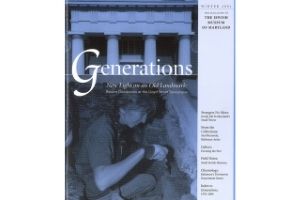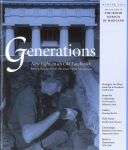Baltimore’s Downtown Department Stores Part 2

 Compiled by K. Meghan Gross, former JMM curatorial assistant. Originally published in Generations – Winter 2001.
Compiled by K. Meghan Gross, former JMM curatorial assistant. Originally published in Generations – Winter 2001.
1888: Hutzler’s department store opens on Howard Street.
Following the trend of acquiring property and expanding retail space, Hutzler’s razed its thee side-by-side buildings to erect an imposing and spacious modern structure on Howard Street. It featured three large bays and utilized cast-iron columns, skylights and crystal chandeliers to enhance the grandeur of its interior. The Sun called the new Hutzler Palace “one of the largest and best arranged buildings of its kind in the United States…a credit to Baltimore and her workmen and a monument to the enterprise and industry of its proprietors.”
1897: The Hochschild Kohn department store opens on November 15th, on the northwest corner of Howard and Lexington Streets just south of Hutzler’s.
Three young men joined forces in 1897 top establish one of the longest-lived enterprises in Baltimore’s retail history. Brothers Louis and Benno Kohn were eyeing the site at the northwest corner of Howard and Lexington to establish a department store, having grown up in their father’s retail dry goods business. Max Hochschild, too, was looking at that corner in the already well-established retail district of downtown Baltimore. The three men decided to enter the department store business together, establishing a new department store palace on Howard Street. Like many store owners, they continued to acquire property and add new departments and services to the business.
1897: The Hub department store opens on Baltimore and Light Streets.
Moses S. Hecht, son of Samuel Hecht, Jr., established The Hub in 1897. This store specialized in men’s and boys’ clothing with fine merchandise and personal service. The Hub building was destroyed in the great fire of 1904 but was rebuilt on Charles Street at the corner of Baltimore Street. The new Hub had four stories of retail space and expanded its stock to include women’s clothing departments. The Hub continued to acquire property along Charles Street and to add more departments.
1899: Posner Brothers erects a grand department store building opposite Hutzler Brothers on Howard Street.
Samuel and Elias Posner came to Baltimore in 1876 from New Jersey and established a store on Lexington Street near Eutaw, moving one block east by 1880. Elias Posner died in 1885, but the business continued to grow. Samuel Posner built his “Palace of Trade” in 1899 at the northeast corner of Howard and Lexington at a cost of $250,000.
1899: Hutzler’s purchases a power-driven truck for delivery service.
Hutzler’s and the other downtown department stores earned a well-deserved reputation for developing new forms of customer service. Testimony abounds about same-day delivery, even of small purchases.
1901-1902 – Posner’s is sold to the Associated Merchants Company of New York and re-named Stewart & Co.
The impressive building proved to be too ambitious for Samuel Posner, and he sold the business to the Associated Merchants Company in 1901. Louis Stewart became the owner and changed the name to Stewart & Co. in 1902. Stewart’s became a well-known Gentile-owned department store, but it was established by Jewish retailers Samuel and Elias Posner.
1904: The Great Baltimore Fire destroys much of the downtown area, coming within blocks of the retail district.
1908: Bernheimer’s opens a new department store annex on Fayette Street near Howard Street.
Among the new arrivals in the Howard and Lexington Street area, Bernheimer Brothers joined in the wave of expansion. Bernheimer Brothers erected an annex building on Fayette Street which featured several floors for selling dry goods, furnishings, and household items. The store also boasted a 300-seat theater and large restaurant. Other features of the building were a working dairy with machines for milking cows and the electric “Bernheimer Bros.” sign on the roof of the building.
1912: Hochschild Kohn expands its Howard Street store after acquiring 206 and 208 North Howard Street.
1916: Hutzler’s erects a new five-story building on Saratoga Street.
In 1924, the store added five additional stories to this building, greatly expanding its sales space.
1923: Bernheimer Brothers merges with The Leader.
After construction of their palace building on Fayette Street, Bernheimer’s continued to look for new opportunities in the downtown retail district. In 1923, the company merged with The Leader, a department store that occupied the southwest corner at Howard and Lexington Streets. The merger provided enough capital to build a new palace building at the corner of Howard and Lexington Streets in 1925. However, Bernheimer-Leader, as it was known, was a short-lived enterprise, and was purchased by the May Company in 1927.
1925: Hutzler’s offers parking lot for customers.
“We make the proud boast of being the first firm in Baltimore to provide parking space for our customers practically right at our doors.” (Tips and Taps, November 1925). The need for parking testifies to the growing influence of the automobile in American life.
1926: Max Hochschild sells his interest in Hochschild Kohn.
After serving for nearly 30 years as a senior partner, Max Hochschild left the management of the highly successful Hochschild Kohn & Co. to his partner’s sons, Walter and Irving Kohn. In later years, Mr. Hochschild remained active in the store’s operation and presided over many opening ceremonies of the branch stores.
1927: The May Company, a national chain, buys Bernheimer-Leader.
Only two years after Bernheimer-Leader built its new department store at Howard and Lexington, the May Co., a department store chain established by Jewish merchant David May, bought out the enterprise. After the May Co. purchased Hecht’s in 1959, this store became known first as Hecht-May and then as the Hecht Company.
